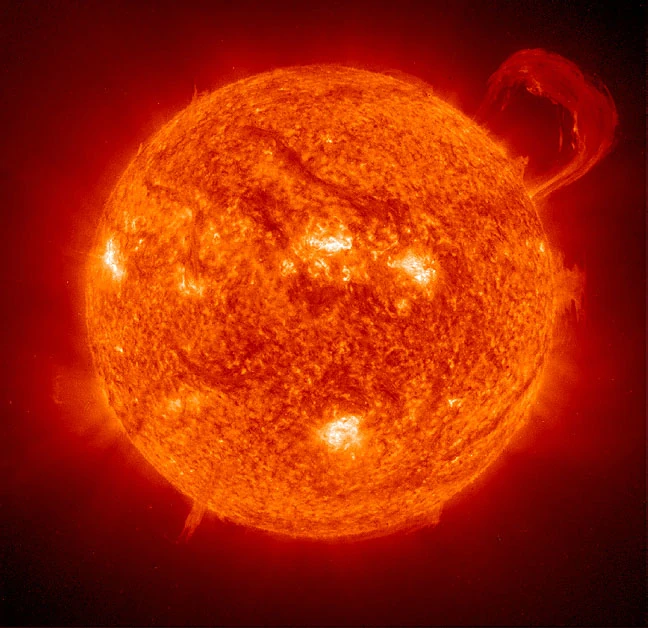
Image: To weigh the Sun, we can use Newton's law of universal gravitation. Image source: NASA
Indeed, thanks to the gravitational force between the Sun and the planet, we can deduce the mass of the Sun.
To weigh the Sun, you must use Newton's law of universal gravitation. This law states that the gravitational force between two objects is proportional to the product of their masses and inversely proportional to the square of the distance between them.
The gravitational force between the Sun and the planet is then given by the following equation:
F = G * M * m / r^2
G = universal gravitational constant, equal to 6.674 × 10^-11 N m^2 kg^-2
M = mass of the Sun, in kilograms
m = mass of the planet, in kilograms
r = distance between the Sun and the planet, in meters
We can also write the equation for Newton's second law, which states that force is equal to mass times acceleration. F = m * a
In the case of the orbital motion of a planet around the Sun, the gravitational force is the only force acting on the planet. Therefore, we can substitute the expression for gravitational force into the equation of Newton's second law.
m * a = G * M * m / r^2
By solving this equation we realize that the mass of the planet m has no importance, so we obtain:
m*a*r^2 = G*M*m
M = a * r^2 / G
This equation allows us to calculate the mass of the Sun M by measuring the acceleration of the Earth around the Sun and the distance between the Sun and the Earth.
The speed of the Earth around the Sun is approximately 30,000 m/s. With the equation below we can calculate that the centripetal acceleration of the Earth.
a_c = v^2 / r
The distance between the Sun and the Earth is known with great precision thanks to parallax. The distance r between the Earth and the Sun is approximately 150 million kilometers or 15 x 10^10 meters.
a_c = v^2 / r = 30,000^2 / 15 x 10^10 = 0.006 m/s^2
This value of 0.006 m/s^2 is very small but sufficient to keep the Earth in a stable orbit around the Sun. This means that the speed of the Earth increases by 0.006 meters per second every second. Centripetal acceleration is what forces the Earth to follow an elliptical path. This acceleration is so weak that we cannot feel it. If the centripetal acceleration were zero, the Earth would continue in a straight line.
In 1795, German astronomer Friedrich Wilhelm Bessel (1784-1846) used this method to estimate the mass of the Sun at 1.99 × 10^30 kilograms. The exact value is 1.9885 ×10^30 kilograms.
Another method to weigh the Sun is to use the law of conservation of energy. This law states that the total energy of an isolated system is constant.
In the case of the Sun-Earth system, the total energy is the sum of the kinetic energy E_k of the Earth and the gravitational potential energy E_p between the Earth and the Sun. The energy conservation equation for the Earth-Sun system is therefore as follows: E_k + E_p = const
The kinetic energy of the Earth is the energy of its movement. It is proportional to the mass of the Earth and the square of its speed. The kinetic energy of the Earth is given by the following equation: E_k = 1/2 * m * v^2
The gravitational potential energy between the Earth and the Sun is the energy due to the force of gravity between the two bodies. It is proportional to the mass of the Earth, to the mass of the Sun and to the inverse of the square of the distance between the two bodies. The potential energy is given by the following equation: E_p = -G*M*m/r
By replacing the expressions of E_k and E_p by their respective formulas, we obtain the following equation: 1/2 * m * v^2 - G * M * m / r = const
m is the mass of the Earth, v is the speed of the Earth, M is the mass of the Sun, and G is the gravitational constant.
If we assume that the Earth's speed is constant, then the Earth's kinetic energy is also constant. The energy conservation equation then becomes: -G * M * m / r = const
Multiplying both sides of the equation by r gives: -G * M * m = const * r
Dividing both sides of the equation by -G * m, we obtain: M = - const * r / G * m
Thus, the constant "const" represents the total energy of the Earth-Sun system. As the kinetic energy of the Earth is constant, we can express the constant in terms of E_k: const = E_k + E_p
Using the expression for E_p, we obtain: const = E_k - G * M * m / r
Assuming that the speed of the Earth is constant, we obtain: const = E_k + G * M * m / r
If the Earth's speed is constant, then the quantity E_k + G*M*m/r must also be constant. We can therefore write: E_k + G * M * m / r = 2 * E_k
Solving this equation for const, we obtain: const = 2 * E_k
Finally, by replacing the constant by its value, we obtain: M = 2 * E_k * r / G
In 1832, the British astronomer John Herschel (1792-1871) used this method to estimate the mass of the Sun at 1.99 × 10^30 kilograms. The exact value is 1.9885 ×10^30 kilograms.
Both methods give identical results, which confirms the validity of the law of universal gravitation.